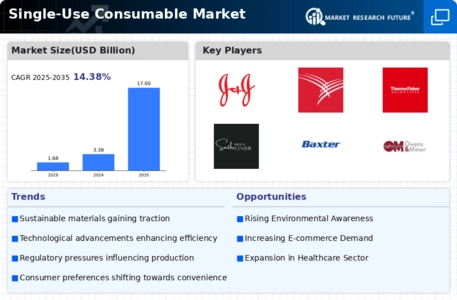The Single-Use Consumable Market is currently characterized by a dynamic competitive landscape, driven by increasing demand for convenience and hygiene across various sectors, including food service, healthcare, and retail. Key players such as Amcor (AU), Berry Global (US), and Sealed Air (US) are strategically positioning themselves through innovation and sustainability initiatives. Amcor (AU) has focused on enhancing its product portfolio with eco-friendly materials, while Berry Global (US) emphasizes operational efficiency and cost leadership. Sealed Air (US) is leveraging technology to improve packaging solutions, thereby enhancing customer experience and operational effectiveness. Collectively, these strategies contribute to a competitive environment that is increasingly focused on sustainability and technological advancement.
In terms of business tactics, companies are localizing manufacturing to reduce lead times and optimize supply chains, which appears to be a response to fluctuating global demand. The market structure is moderately fragmented, with several players vying for market share, yet the influence of major companies remains substantial. This competitive structure allows for innovation and differentiation, as smaller firms often adopt niche strategies to compete against larger entities.
In September 2025, Amcor (AU) announced a partnership with a leading food manufacturer to develop a new line of biodegradable packaging solutions. This strategic move not only aligns with the growing consumer preference for sustainable products but also positions Amcor as a leader in eco-friendly packaging, potentially enhancing its market share in the environmentally conscious segment.
In August 2025, Berry Global (US) unveiled a new manufacturing facility in Mexico, aimed at increasing production capacity for its single-use products. This expansion is significant as it allows Berry to better serve the North American market, reduce shipping costs, and respond more swiftly to customer demands, thereby strengthening its competitive position in the region.
In July 2025, Sealed Air (US) launched an innovative packaging technology that utilizes artificial intelligence to optimize packaging design and reduce material waste. This development is crucial as it not only enhances operational efficiency but also addresses the growing concern over environmental impact, positioning Sealed Air as a forward-thinking player in the market.
As of October 2025, the competitive trends in the Single-Use Consumable Market are increasingly defined by digitalization, sustainability, and the integration of advanced technologies such as AI. Strategic alliances are becoming more prevalent, as companies seek to enhance their capabilities and market reach. Looking ahead, it is likely that competitive differentiation will evolve from traditional price-based competition to a focus on innovation, technological advancements, and supply chain reliability, reflecting the changing preferences of consumers and regulatory landscapes.


















Leave a Comment